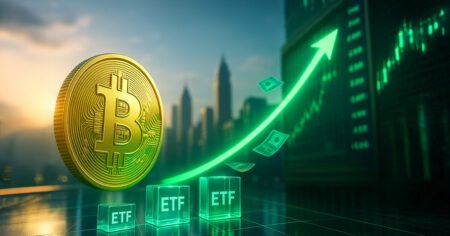Bitcoin ETFs: Surging Trading Volumes Amid Tariff Turmoil
In recent days, Bitcoin Exchange-Traded Funds (ETFs) have experienced a significant spike in trading activity, particularly on October 10 and 13, where combined volumes reached an astonishing $9.7 billion and $6.7 billion, respectively. This surge stands in stark contrast to the typical trading volumes of $2-3 billion, indicating a potential frenzy of buying and selling rather than straightforward accumulation. The catalyst for this dramatic uptick? Escalating tariff threats from US policymakers have rattled the broader risk markets, pushing investors to seek refuge and opportunity in Bitcoin ETFs.
Factors Behind the Trading Frenzy
The catalyst for the rise in Bitcoin ETF volume lies within a perfect storm of macroeconomic factors; most notably, fears surrounding impending tariffs on Chinese imports. On October 10, the announcement of potential 60% tariffs sent shockwaves through global markets and exacerbated existing concerns about trade wars and inflationary pressures. As Bitcoin plunged nearly 18% from $122,600 to $102,546, it created a fertile ground for trading, leading many investors to reposition their strategies. This volatility made Bitcoin ETFs, especially BlackRock’s IBIT, an attractive vehicle for executing rapid trades without the complexities associated with direct Bitcoin ownership.
The Divergence Between Volume and Inflows
While the spike in trading volume is impressive, it is essential to differentiate between gross trading activity and net inflows. Data from Farside indicates that on October 10, while trading volumes soared to nearly $10 billion, net outflows amounted to only -$5.7 million. This discrepancy illustrates that, despite heightened trading, true capital additions remained relatively subdued. In volatile periods, such as this one, turnover can skyrocket due to frequent buy and sell transactions, while net inflows may lag considerably, underscoring the complexity of understanding market dynamics.
Short-Term Speculation vs. Long-Term Investment
It is crucial to understand the role of short-term speculators during this recent trading frenzy. Leveraged plays on platforms such as CME futures intensified the volatility, resulting in rapid shifts in ETF liquidity. Unlike periods of steady accumulation where inflows align with trading volumes, the recent spike involved a sort of ‘adrenaline rush’ among traders. Products like the IBIT ETF, with a low expense ratio of 0.25%, have transformed into frictionless on-ramps for capitalizing on Bitcoin’s wild price swings. As investors assess their positions amidst fluctuations, many long-term holders opted to trim their stakes, locking in the gains from Bitcoin’s summer rally.
Market Resilience and Future Outlook
After the initial frenzy, Bitcoin’s price rebounded slightly to $115,250 by October 13, marking a 2.3% increase since the drastic drop. However, caution has captivated the markets, leading to a surge in outflows, which reached $326.4 million on the same day. Such balance between inflows and outflows indicates a more tempered approach from investors, especially when faced with ongoing tariff rhetoric. While the initial chaos may disguise underlying flows, the settling market brings clarity to trading dynamics, highlighting a proclivity for sellers to dominate in uncertain times.
Implications of Tariff Threats on Bitcoin Prices
The persistent fears surrounding tariffs are likely to sustain heightened trading volumes in the upcoming weeks. As trade tensions persist, Bitcoin’s price could face pressure, hovering around $111,000 as of the latest updates. The potential for increased ‘flight to volatility’ trades may further compel Bitcoin ETF turnover toward $10 billion regularly. However, without corresponding net inflows surpassing $750 million per day, the sustainability of any price gains will rely heavily on broader macroeconomic relief.
Conclusion
In summary, the surge in Bitcoin ETF trading activity reflects a complex interplay of market forces driven by macroeconomic shocks and investor sentiment. As traditional risk assets grapple with tariff concerns, Bitcoin has emerged as a hedge, albeit one characterized by volatility and speculation. With trading volumes soaring amid tariff threats, stakeholders in the Bitcoin ecosystem must remain vigilant. Understanding the distinction between trading volume and net inflows is crucial for interpreting market signals and forming reliable investment strategies moving forward. The coming weeks will be pivotal in determining whether this volatility damps or ignites long-term interest in Bitcoin ETFs.

















